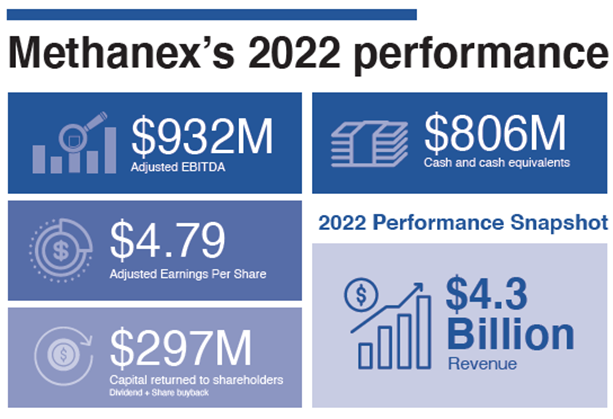Alternative energy has been the subject of intense debate in recent years, but most of these discussions fail to include all forms of carbon-based fuels. While solar, wind, biomass, hydroelectricity and geothermal are the most popular with the green energy crowd, methanol has often been left out of the discussion. That’s starting to change now, giving you a backdoor way to profit – Methanex (MEOH), advises Tony Sagami, editor of Disruptors & Dominators.
Demand for methanol is quietly and steadily growing as the leading clean alternative to conventional transportation fuels. The global market for methanol reached $35 billion in 2021 and is expected to reach $54 billion by 2030.
That is money in the bank for methanol producers, especially Methanex, the largest producer of methanol in the world with a 13% market share. Methanex has 11 methanol plants in five countries — the U.S, Canada, New Zealand, Argentina and Egypt — with capacity to produce 9.3 million metric tons a year.
Business is so good that Methanex is building a $1.3 billion plant in Geismar, Louisiana, that will expand its production capacity by almost 20% to 11.1 million tons a year when completed in 2024. This new “G-3” plant is adjacent to Methanex’s existing G-1 and G-2 plants.
The beauty of the G-3 plant is it will share some of the existing G-1 and G-2 plants’ infrastructure — such as existing railroad lines, natural gas pipelines, shipping fleet and loading docks for sea transportation.
It is also important to note that Methanex owns the world’s largest methanol ocean tanker fleet. And G-3 will use the excess steam generated from G-1 and G-2 as its primary energy source — a huge deal because that will cut the cost of producing methanol by roughly 35%.
This will make the G-3 plant one of the lowest carbon dioxide-emitting plants and one of the lowest-cost producers and methanol plants in the world. When it comes to commodities like energy, minerals and natural resources, the low-cost producer is the most profitable.

Meanwhile, in 2022, Methanex generated $4.3 billion of revenue and $4.79 per share of profit. Over the last three years, Methanex has grown its profits by an average of 33% compounded.
Methanex also pays an 18-cent quarterly dividend, which translates into a 1.5% dividend yield.
While that may not sound like a lot, Methanex has raised its dividend for the last three years in a row and should do so again once the G-3 plant starts producing profits. The next dividend will be paid toward the end of June.
Recommended Action: Buy MEOH.










